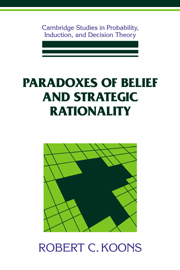Book contents
- Frontmatter
- Contents
- Preface
- Introduction
- Part I Paradoxes
- Part II Solutions
- 5 A critique of context-insensitive solutions to the liar paradox
- 6 Three context-sensitive solutions to the liar paradox
- 7 Applying the context-sensitive solutions to doxic paradox
- Conclusion
- Appendix A Applying probability to mathematical sentences
- Appendix B Proofs of Theorems 2 and 3 from Chapter 6
- Appendix C On schematic generalization
- Bibliography
- Index
7 - Applying the context-sensitive solutions to doxic paradox
Published online by Cambridge University Press: 06 January 2010
- Frontmatter
- Contents
- Preface
- Introduction
- Part I Paradoxes
- Part II Solutions
- 5 A critique of context-insensitive solutions to the liar paradox
- 6 Three context-sensitive solutions to the liar paradox
- 7 Applying the context-sensitive solutions to doxic paradox
- Conclusion
- Appendix A Applying probability to mathematical sentences
- Appendix B Proofs of Theorems 2 and 3 from Chapter 6
- Appendix C On schematic generalization
- Bibliography
- Index
Summary
In applying the context-sensitive solutions to paradoxes involving rational belief and strategy, there are several choices to be made. First, there is a choice concerning the objects of belief, specifically, whether real things are involved directly in these objects of belief or only indirectly (via some representations of those things). This distinction corresponds to one that logicians have traditionally made between de re and de dicto treatments of belief. On a de re account, if one thinks that Mt. Blanc is snowy, then the object of one's belief is something that contains the mountain itself as well as, perhaps, the property of snowiness. As a consequence of this ontological claim, the de re theorist must hold that two names that designate the same object must be intersubstitutable in belief contexts salve veritate (i.e., without effect on the truth-value of the report). In contrast, on a de dicto account, if one thinks that Mt. Blanc is snowy, one's thought contains, not Mt. Blanc itself, but some representation or mode of presentation of that mountain. If different proper names of a thing correspond to different representations of that object, then they will not, on the de dicto account, be intersubstitutable salve veritate in belief contexts.
If the de re theorist insists that the objects of belief consist of sets of possible worlds (as in modal doxic logic) or constructions of objects and properties in traditional, well-founded set theory (as in theories that follow the lead of Betrand Russell), then the sort of circularity that produces self-referential liar-like paradoxes can be averted. However, as I argued in Part I, this is neither necessary nor desirable.
- Type
- Chapter
- Information
- Paradoxes of Belief and Strategic Rationality , pp. 123 - 149Publisher: Cambridge University PressPrint publication year: 1992

